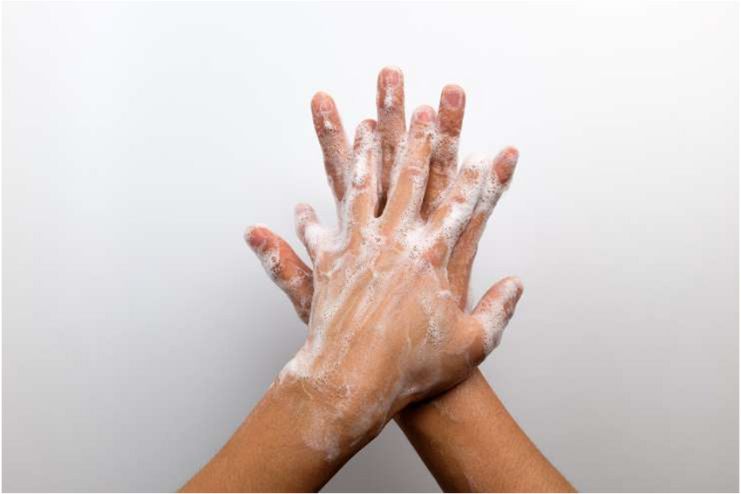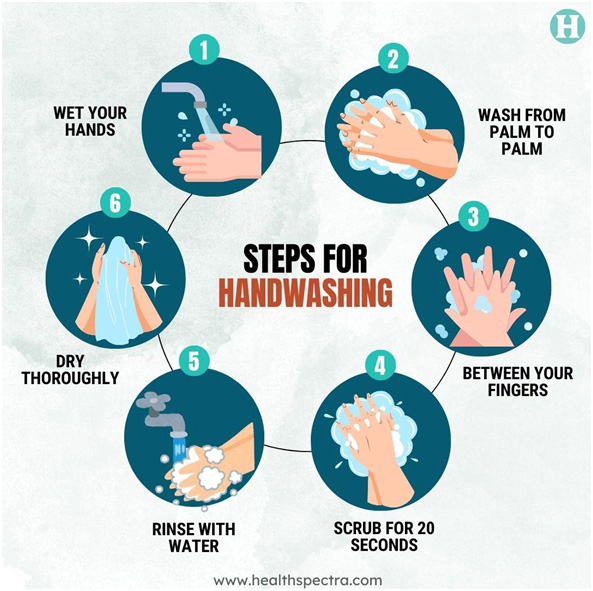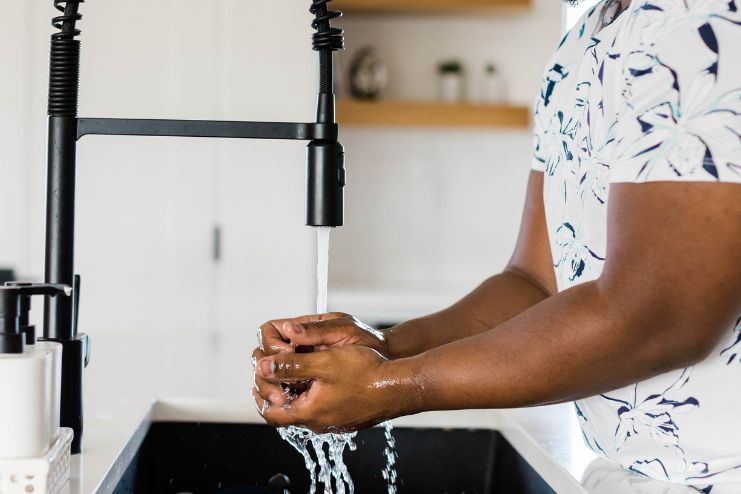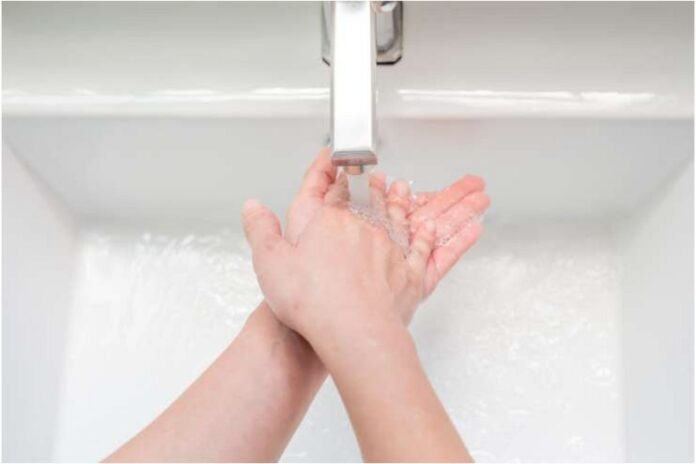AI Contribution
At HealthSpectra, we may use AI to refine grammar and structure, but every piece is shaped, checked, and approved by real people, our expert writers and editors, to ensure clarity, credibility, and care. Learn more..Affiliate Disclaimer
Some links in this article are affiliate links. We may earn a small commission if you make a purchase through these links, at no extra cost to you. We only recommend products we find useful to our readersHave you ever wondered how something as basic as washing your hands may protect you from tiny invaders?
Despite their apparent cleanliness, our hands are magnets for bacteria and viruses, which they can pick up via handshakes, sneezes, and surfaces.
National Handwashing Awareness Week is an annual reminder of the most simple yet effective instrument we have to protect our health: our own hands. The initiative emphasizes how crucial good hand hygiene is for saving lives. But why is this week so important?
According to the Centers for Disease Control and Prevention (CDC), frequent handwashing can cut the spread of colds and other respiratory ailments by 21%, up to a 31% decrease in the number of cases of diarrheal illness, and lower diarrheal sickness by 58% in individuals with compromised immune systems. This seemingly small action has a rippling effect, benefiting vulnerable populations and lowering healthcare costs.
By prioritizing handwashing, we’re fostering healthier communities and protecting ourselves.
This article explores the processes of hand hygiene and its significant role in safeguarding public health.
The Science Behind Handwashing: Why It Works

Microscopic invaders such as bacteria and viruses travel on the oils and grime that naturally build up on our skin when we contact infected objects. Shaking hands, touching items, or unintentionally raising our hands to our faces can easily transmit these diseases to other people.
Soap molecules are what make handwashing so effective. The unique structure of soap, which has been used for thousands of years, aids in destroying the virus. According to Rebecca Gallego, senior principal scientist in medicinal sciences at Pfizer, “Soap works because it’s the right structure to do the job.”
Two things happen when we wash our hands with soap:
- the soap lowers the water’s surface tension
- it attaches itself to the oil, grime, and bacteria.
The soap molecule’s hydrogen, carbon, and oxygen atoms form a chain. This chain has two ends: one that is hydrophilic or attracted to water and the other that is lipophilic or drawn to oil. Therefore, the molecules’ lipophilic ends absorb the oil, grime, and bacteria as we lather up.
The oil, grime, and bacteria are then rinsed off our hands and down the drain when we clean them because the hydrophilic ends of the molecules follow the water. Proper hand washing with soap and water can prevent the germs that cause these illnesses from spreading.
Handwashing is science in action, not just a custom.
The Role of Handwashing in Preventing Illness
Throughout the day, you come into contact with people, surfaces, and items like doorknobs and cell phones, which are teeming with bacteria and viruses. You can distribute these germs to others or infect yourself by touching your mouth, nose, or eyes. Washing your hands with soap and water can help reduce the spread of bacteria, viruses, the common cold, flu, COVID-19, diarrheal illnesses, and other pathogens.
History can teach us vital lessons on the need for clean hands. In the 19th century, Dr. Ignaz Semmelweis instituted handwashing for medical personnel. Frequent handwashing was a key component of preventive measures during the COVID-19 pandemic, which helped restrict the virus’s global spread.
Hand hygiene has a profound impact on economies in addition to personal health. Workplaces can experience a 40% decrease in absenteeism by implementing good hygiene standards, which translates into increased productivity and fewer sick days.
In addition to keeping yourself healthy, you support worldwide efforts to prevent disease, save lives, and improve public health every time you wash your hands.
Proper Handwashing Technique
Consider handwashing your superpower—it’s easy yet incredibly efficient at keeping deadly germs away from you and others. However, like any other superpower, it functions best when performed properly.
 Here’s your comprehensive guide to mastering handwashing:
Here’s your comprehensive guide to mastering handwashing:
Wet your hands: Use fresh, running water to begin; warm or cold water will do.
Make a lather by liberally applying soap and allowing it to do its job. Pay attention to the areas where germs prefer to hide—the palms, backs of your hands, in between your fingers, and beneath your nails.
Scrub smart: Timing is everything. Spend at least 20 seconds cleaning thoroughly (if unsure, sing “Happy Birthday” twice).
Rinse well: Run water over the area to remove the dirt and bacteria you’ve released.
Dry entirely: Using a fresh towel or air dryer will stop fresh bacteria from adhering to wet skin.
Hand washing isn’t limited to the time after using the restroom. Every time you cough, sneeze, or eat, your hands have probably come into contact with pathogens. Cleaning them up after coughing or sneezing stops the transmission of diseases, and washing them before meals keeps bacteria off your plate.
Handwashing for Kids: Make It Fun and Educational

Parents and caregivers are responsible for teaching children to wash their hands. Teaching handwashing at a young age can help it become a healthy habit that lasts a lifetime. Teach children the five simple processes of handwashing: wet, lather, scrub, rinse, and dry. Teach them the importance of washing their hands at specific times, such as before eating or after using the restroom.
Start with music: Handwashing remixes of well-known nursery rhymes are a fun way to boost the chorus on the traditional “Happy Birthday” song, which is sung twice. As you lead them through the steps, sing “Wash, Wash, Wash Your Hands” to the melody of “Row, Row, Row Your Boat.”
Create a Kid-Friendly Station: Provide a stool and high-quality antibacterial soap to create a kid-friendly handwashing station at home. Hand washing will be less of a chore if it’s simple for your kids. For your child to truly take satisfaction in washing their hands by themselves, let them select their materials, such as an excellent towel for drying their hands afterward.
Make It a Game: Encourage handwashing by turning it into a fun challenge. One suggestion is to play “Whose hands smell the cleanest?” They might even play it with their buddies at school, ensuring their hands receive a good cleaning.
Teach About Germs with Visual Aids: Use glitter to demonstrate how germs stick to hands. Show how much easier it is to wash them off with soap to help your kids understand the importance of good hygiene.
Handwashing in the Workplace and Public Spaces
Maintaining good hand hygiene is the unsung hero of protecting everyone’s health in common areas, including workplaces, schools, and public places. Here are some tips for improving handwashing in these settings:
Be Ready: Always keep paper towels and soap dispensers filled. Ensure sinks are correctly outfitted to urge individuals to wash their hands.
Provide Hand Sanitizer: Hand washing with soap and water is more effective, but sanitizer dispensers should be placed in common areas to promote frequent hand cleansing. Hand sanitizer can help destroy harmful bacteria and halt disease transmission.
Use Signage: Place signs in kitchens and restrooms reminding people to wash their hands. Sometimes, a simple reminder is all it takes to convince someone to stop and clean up.
Gamify Hygiene: Set up contests such as “Clean Hands Champions,” where staff members or students receive points for adequately washing their hands. Make cleanliness a gain for the whole community!
Workplaces and public areas can become health centers where everyone feels empowered to keep themselves—and each other—safe by promoting a handwashing culture.
National Handwashing Awareness Week: How to Get Involved

During National Handwashing Awareness Week, you can change your community. Participate in exciting projects like holding workshops on handwashing at community centers, libraries, or schools. Work with neighborhood groups to give away free soap bars or hand sanitizers—small gestures that can make a significant difference.
Resources are available for educators and medical professionals to raise awareness. Downloadable lesson plans and interactive resources like coloring pages and handwashing songs help schools make learning enjoyable. Healthcare providers can teach good hygiene through movies, infographics, and posters in clinics and hospitals.
To get you started, here are some helpful resources:
WHO Campaign Tools: Access Global Handwashing Resources
Remember that even modest efforts can significantly impact communities being cleaner and healthier.
Conclusion
Handwashing is a public health superpower that saves lives, lowers the spread of disease, and builds stronger communities. It is more than just a personal habit. Good hygiene can contribute to a safer and healthier planet.
It is now your moment to make a difference! Adopt improved personal hygiene practices and encourage others to follow. We can transform this small deed into a worldwide health and well-being movement by working together. Clean hands and a brighter future!
References
- https://www.cdc.gov/clean-hands/data-research/facts-stats/index.html
- https://www.bestsanitizers.com/the-science-behind-handwashing
- https://my.clevelandclinic.org/health/articles/17474-hand-washing
- https://www.health.state.mn.us/people/handhygiene/wash/howsoap.html
- https://pmc.ncbi.nlm.nih.gov/articles/PMC8394668/
- https://www.cdc.gov/clean-hands/about/index.html
- https://www.medicalnewstoday.com/articles/proper-hand-washing#step-by-step-guide
- https://www.healthline.com/health/7-steps-of-handwashing#handwashing-steps
- https://www.betterhealth.vic.gov.au/health/conditionsandtreatments/handwashing-why-its-important
- https://www.cdc.gov/clean-hands/data-research/facts-stats/index.html
- https://www.mayoclinic.org/healthy-lifestyle/adult-health/in-depth/hand-washing/art-20046253
- https://pmc.ncbi.nlm.nih.gov/articles/PMC6053623
- https://www.npr.org/sections/health-shots/2015/01/12/375663920/the-doctor-who-championed-hand-washing-and-saved-women-s-lives
- https://www.kcprofessional.com/en-us/workplace-insights/health-and-safety/hand-washing-guide
- https://www.who.int/teams/integrated-health-services/infection-prevention-control/hand-hygiene
- https://doh.wa.gov/community-and-environment/schools/environmental-health/handwashing
- https://iris.who.int/bitstream/handle/10665/350184/9789240036444-eng.pdf
- https://www.lysol.com/clean-and-protect/tips-for-parents/hand-washing/making-hand-washing-for-kids-fun
- https://www.cdc.gov/clean-hands/prevention/index.html
- https://www.youtube.com/watch?v=fDR_pRHYMGA
- https://www.youtube.com/watch?v=M4D3p6tg42I
- https://www.cdc.gov/clean-hands/prevention/about-hand-hygiene-at-work.html
- https://www.who.int/campaigns/world-hand-hygiene-day
- https://www.betterhealth.vic.gov.au/health/conditionsandtreatments/handwashing-why-its-important
- https://www.pfizer.com/news/articles/how_soap_works_the_science_behind_handwashing
In this Article





















